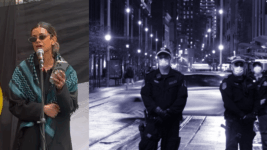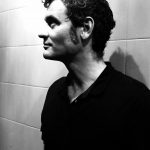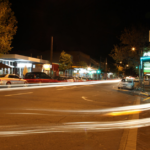The Offence of Recklessly Causing Grievous Bodily Harm in NSW

The senior New South Wales police officer who punched legal observer Hannah Thomas in the right eye, during a 27 June 2025 antigenocide protest on Bidjigal land outside the SEC Plating premises in the Sydney suburb of Belmore, has been charged for the second time with the more serious offence of recklessly causing grievous bodily harm.
Those following the case have welcomed the significantly more serious charge, which accompanies an initial count of assault occasioning actual bodily harm that was laid against the officer in September 2025. The new charge has been laid in recognition of the “severity of the injury” that almost blinded Thomas in one eye.
The incident and subsequent dealing with it on the part of the NSW Police Force has comprised a travesty of justice, as after a police officer severely injured a legal observer at a protest, attending officers then charged Thomas, a lawyer, with resisting a police direction, which is the usual state law enforcement practice that involves charging the civilian police assaulted as if the victim was at fault.
Not only was Thomas initially charged, but the offence laid against her name involved a failure to follow a direction during a large-scale public disorder, rather than the regular offence. So, officers appeared to be framing the rally as some kind of riot to justify the police brutality. And the offending officer was charged 3 months later, and only after released footage clearly showed he punched her.
Reckless GBH in NSW
The offence of recklessly causing grievous bodily harm is one of a number of assault offences on the NSW books, and it sits under subsection 35(2) of the Crimes Act 1900 (NSW). If the senior police officer who king hit the civilian legal observer in the face is found guilty of this charge, then he’ll be facing up to 10 years imprisonment.
To establish that a defendant is guilty of a charge under subsection 35(2) of the Crimes Act, the prosecution must prove that they caused grievous bodily harm, which translates as “very serious harm” that can entail permanent damage or disfigurement to the victim, the destruction of a foetus in a manner other than surgical, as well as the transmitting of a grievous bodily disease.
If the police officer or another offender is found to have committed the offence of recklessly causing grievous bodily harm in company, or whilst at least with one other person, then they’re guilty of the more serious offence of recklessly cause GBH in company that sits under subsection 35(1) of the Crimes Act, and the maximum penalty climbs to 14 years.
The fact that the offence was carried out ‘recklessly’ is also important. To commit a crime in a reckless manner means that the offender wasn’t intentionally trying to achieve this outcome, but rather it conveys that the doer of the action was aware of the risks and resulting consequences that could and did occur at the time of commission, but they continued to act in this manner regardless.
The defences that the NSW senior police officer will have available to him at trial are self-defence, which sits under section 418 of the Crimes Act, and would infer that he’d punched Thomas to defend himself or someone else.
The defence is also available when a crime is said to have been perpetrated to prevent one’s own or another’s unlawful detainment or to protect one’s property or to prevent criminal trespass.
A defendant can also argue the defence of duress, which involves acting in a criminal manner due to a threat of death or serious injury being made against them or one of their family members, as well as the defence of necessity, which involves an individual being induced to break the law due to circumstances that were bearing down upon them.
Related offences
If the evidence related to the senior NSW police officer suggested that he intentionally punched Thomas in a manner that sought to produce the significant damage that resulted to her eye, then NSW police would have laid the charge of intent to cause grievous bodily harm, contrary to subsection 35(1) of the Crimes Act. This offence carries up to 25 years imprisonment.
While the initial charge that was laid against the senior officer in September, and remains against his name, involves one count of assault occasioning actual bodily harm, contrary to subsection 59(1) of the Crimes Act. If the senior NSW police officer who punched Thomas in the face is found guilty of this crime, he will be facing up to five years inside a NSW correctional facility in respect of it.
To prove actual bodily harm has occurred, the prosecution must show that any hurt or injury is significant enough to interfere with the regular health or comfort of the victim. Such an injury does not constitute permanent damage, but it must be more than a mere transient or trifling harm to the victim’s body.
The Office of the NSW Director of Public Prosecutions (ODPP) notes that “grievous bodily harm means really serious bodily injury that results in any permanent or serious disfiguring of the person”, while “if the harm is not considered to be grievous then the harm is actual bodily harm”, which involves “any hurt or injury that interferes with the health or comfort of a person”.
Attempted coverup debacle
In the wake of the incident, NSW police assistant commissioner Brett McFadden conveyed to the public that there was nothing suspicious in the footage that ultimately showed the lawyer being punched in the eye by the senior NSW police officer.
However, a critical incident was called in respect of this police assault on a civilian the following week, which then results in state’s police watchdog the Law Enforcement Conduct Commission (LECC) oversighting the internal police investigation.
The 33-year-old senior NSW police officer was presented with a 22 October court attendance notice (CAN), which listed the more recent charge alongside the prior one. The charges laid against Thomas were dropped in September at the time that the officer was initially charged.
The protest that Thomas was providing legal observance to was against Australian company SEC Plating, as antigenocide activists allege it supplies steel plating that assists in building the F-35 fighter jets that have been and continue to be used by Israel in the commission of the Gaza genocide.
The senior officer who allegedly punched Thomas is set to appear before Bankstown Local Court on 18 November 2025, whilst the lawyer’s legal team will be taking civil legal action against the NSW police force and the state of NSW over the illegal assault against her, as she was merely observing an early morning protest.







